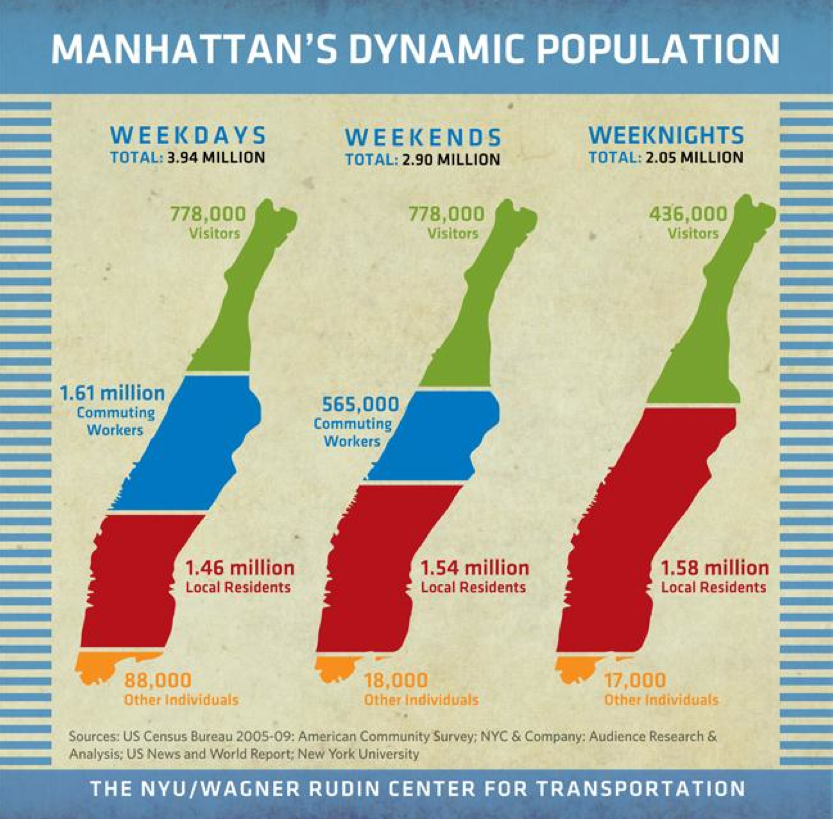NYU RUDIN CENTER
Introduction
We cannot understand Manhattan in the 21st century by relying on conventional measures of urban activity. Simply put, Manhattan consists of much more than its residential population and daily workforce. This island, measuring just 22.96 square miles, serves approximately 4 million people on a typical weekday, 2.9 million on a weekend day, and a weekday night population of 2.05 million. Manhattan, with a residential population of 1.6 million more than doubles its daytime population as a result of the complex network of tunnels, bridges, railroad lines, subways, commuter rail, ferry systems, bicycle lanes, and pedestrian walkways that link Manhattan to the surrounding counties, cities and towns.
This transportation infrastructure, largely built during the twentieth century, is operated by the City of New York, Metropolitan Transportation Authority, and Port Authority of New York & New Jersey. The infrastructure network generates a constant flow of people who are responsible for Manhattan’s emergence as a world capital for finance, media, fashion, and the arts.
The residential population count does not include the 1.6 million commuters who enter Manhattan every weekday, or the hundreds of thousands of visitors who use Manhattan’s tourist attractions, hospitals, universities, and nightclubs. This report analyzes the volume of people flowing in and out of Manhattan during a 24-hour period; we provide an upper estimate of the actual number of people in Manhattan during a typical work day.
Manhattan: A city of 4 million
- Manhattan’s daytime population is approximately 3.94 million; the census- defined daytime population omits almost one-fourth of the total, or nearly 800,000 people. The daytime population consists of approximately 1.61 million commuting workers, 1.46 million local residents, 404,000 out-of-town visitors, 374,000 local day-trip visitors, 17,000 hospital patients, and 70,000 commuting students.
- 52% of Manhattan’s Census-defined daytime population consists of individuals who do not live in Manhattan and commute there for work. Every day, 1.63 million commuters enter Manhattan for work, while 132,000 Manhattan residents commute elsewhere for work
- According to the US Census definition of “daytime population,” there are approximately 3.1 million people in Manhattan during the work day, compared to a residential population of 1.6 million people at night.
- The weekend daytime population of Manhattan is approximately 2.9 million people, with 565,000 commuting workers and 1.54 million local residents; the weekday night time population is at most 2.05 million, suggesting that there could be to up to 471,000 more people in Manhattan at night consisting of late night workers, “night-trip” visitors from the outer boroughs and suburbs, hospital patients, and overnight visitors, in addition to the 1.58 million local residents.
- The total number of people in Manhattan can vary dramatically at different times of the day and week. Population estimates based on the US Census measure the residential population of each neighborhood, but the population density of key areas of Manhattan are substantially greater during the day with the inflows of commuters, and certain neighborhoods attract visitors at night in far excess of the residential population.
- Peak population events, or “day-trip” events, draw in people from across the city and region could potentially push Manhattan’s daytime population well above 4 million, perhaps even 5 million, depending on the conditions and circumstances.
- Manhattan has the greatest increase in population during the day among all U.S. counties or administrative equivalents (+1.49 million), and the highest ratio between day and night population (1.92), which suggests that there are nearly double as many people in Manhattan during the day than at night during a typical work day.
- Queens, Brooklyn, and The Bronx, in that order, have the greatest decrease in population during the day of all U.S. counties; there are approximately 366,000 fewer people in Queens during the day than at night.
- Four out of every five Manhattan-bound commuters from the outer boroughs and suburbs travel to work by public transit each day: 50.1% by subway, 17.1% by rail, and 13.8% by bus. Recent trends in subway ridership indicate that the greatest increase in trips by time of day over the past decade occurred during late night hours, from 7 PM to 6 AM, and during weekends, highlighting that population flows into, out of, and within Manhattan are no longer occurring only at peak commuting hours.
- Manhattan’s capacity to accommodate high volumes of population flow allows it to serve as the transaction-maximizing place (Meier, 1968).
Read full report (PDF) here: The Dynamic Population of Manhattan
About The Rudin Center for Transportation Policy and Management
wagner.nyu.edu/rudincenter
“The Rudin Center for Transportation Policy and Management at NYU’s Wagner school explores current and emerging challenges in transportation and infrastructure. The Center draws upon faculty and graduate students from NYU to conduct research on issues such as financing transportation systems, the role of mobile communications in mobility, the neuroscience of walking, and aviation and economic development.”
Tags: New York, population, tourism, transportation







 RSS Feed
RSS Feed